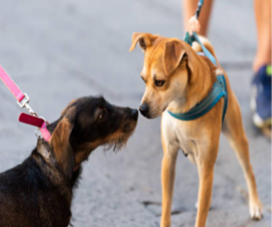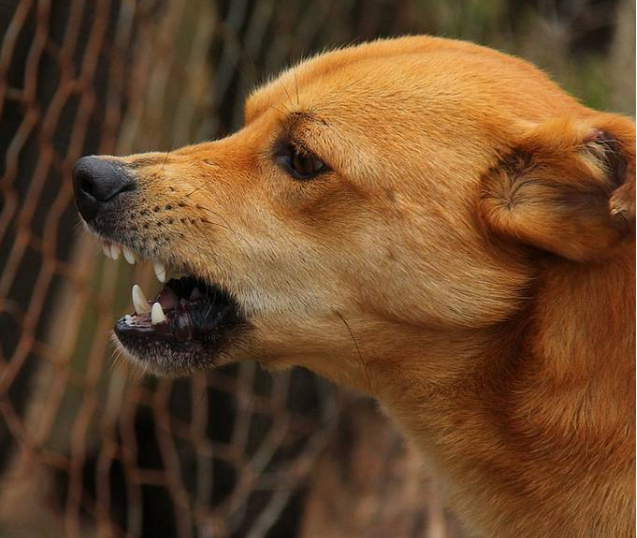April 17, 2025
 Why a Loose Leash Is Crucial for On-Leash Dog Introductions
Why a Loose Leash Is Crucial for On-Leash Dog Introductions
Introducing dogs while they’re on-leash can be tricky—even risky—if not done correctly. One of the most effective ways to support a smooth and safe introduction is by keeping the leash loose.
 The Problem With a Tight Leash
The Problem With a Tight Leash
Dogs are extremely sensitive to leash pressure. A tight leash doesn’t just restrict movement; it also increases emotional tension. When a dog feels physically restrained, it may perceive the other dog as a threat, triggering defensive or reactive behavior.
Tension travels down the leash—literally and figuratively. It alters body language, raises arousal, and limits a dog’s ability to use calming signals or make natural choices during greetings.
 How a Loose Leash Supports Canine Communication
How a Loose Leash Supports Canine Communication
A loose leash lets dogs:
-
Move more fluidly
-
Read each other’s body language
-
Choose their proximity and pace
-
Use natural greeting behaviors like curving and sniffing
These choices allow for more organic and stress-free interactions. Dogs can signal comfort or discomfort in ways that are easy for the other dog to interpret—leading to better outcomes and fewer misunderstandings.
 What to Do If You Feel the Need to Control
What to Do If You Feel the Need to Control
It’s common to feel nervous during introductions, but tightening the leash is rarely the answer. Instead, control the environment, not the dog. Try these strategies:
-
Create more space by walking parallel at a distance
-
Observe both dogs for relaxed body language
-
Only allow closer contact if both dogs remain calm and loose
When in doubt, back up and give the dogs more room to breathe.
Pro Tip: A calm handler with a slack leash helps build a calm dog. That calmness is contagious.
 Free Download: On-Leash Dog Introduction Guide
Free Download: On-Leash Dog Introduction Guide
Want a printable version of these tips?
 Download my free on-leash dog introduction guide (PDF) to help your next greeting go smoothly.
Download my free on-leash dog introduction guide (PDF) to help your next greeting go smoothly.
 Why a Loose Leash Is Crucial for On-Leash Dog Introductions
Why a Loose Leash Is Crucial for On-Leash Dog Introductions
Introducing dogs while they’re on-leash can be tricky—even risky—if not done correctly. One of the most effective ways to support a smooth and safe introduction is by keeping the leash loose.
 The Problem With a Tight Leash
The Problem With a Tight Leash
Dogs are extremely sensitive to leash pressure. A tight leash doesn’t just restrict movement; it also increases emotional tension. When a dog feels physically restrained, it may perceive the other dog as a threat, triggering defensive or reactive behavior.
Tension travels down the leash—literally and figuratively. It alters body language, raises arousal, and limits a dog’s ability to use calming signals or make natural choices during greetings.
 How a Loose Leash Supports Canine Communication
How a Loose Leash Supports Canine Communication
A loose leash lets dogs:
-
Move more fluidly
-
Read each other’s body language
-
Choose their proximity and pace
-
Use natural greeting behaviors like curving and sniffing
These choices allow for more organic and stress-free interactions. Dogs can signal comfort or discomfort in ways that are easy for the other dog to interpret—leading to better outcomes and fewer misunderstandings.
 What to Do If You Feel the Need to Control
What to Do If You Feel the Need to Control
It’s common to feel nervous during introductions, but tightening the leash is rarely the answer. Instead, control the environment, not the dog. Try these strategies:
-
Create more space by walking parallel at a distance
-
Observe both dogs for relaxed body language
-
Only allow closer contact if both dogs remain calm and loose
When in doubt, back up and give the dogs more room to breathe.
Pro Tip: A calm handler with a slack leash helps build a calm dog. That calmness is contagious.
 Free Download: On-Leash Dog Introduction Guide
Free Download: On-Leash Dog Introduction Guide
Want a printable version of these tips?
 Download my free on-leash dog introduction guide (PDF) to help your next greeting go smoothly.
Download my free on-leash dog introduction guide (PDF) to help your next greeting go smoothly.







